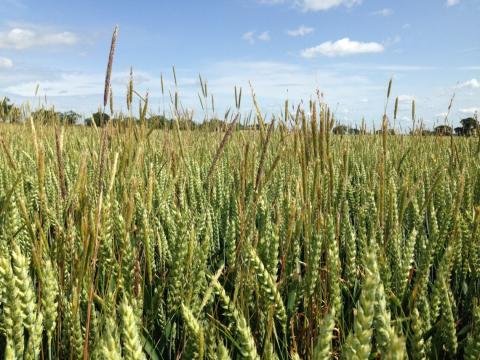Black-grass thrives on heavy land, particularly where drainage is poor. Now a new study has shown that this problematic weed uses specific adaptations to flourish even when soil is totally saturated for up to three weeks. The data show that when waterlogged, black-grass plants grow bigger than their well-drained counterparts while wheat growth under the same conditions was significantly reduced.
The research also examined different populations of black-grass and showed that the more herbicide resistant the population was, the more waterlogging tolerant it was too.
Other studies have shown that weed competition early in crop development has the greatest impact on yield. These findings suggest fields infested with herbicide resistant black-grass are going to be badly affected by autumn waterlogging. The results also help to explain why black-grass tends to form patches in areas of the field where the soil is good at holding onto water.
“This is an important step forward in our understanding of what makes black-grass so resilient,” said Rothamsted’s Dr Dana MacGregor who led the research. “We are getting closer to pinpointing the physical and genetic mechanisms that make black-grass such a formidable foe for cereal farmers.”
For the study, seedlings of wheat and black-grass were flooded for up to 21 days in pots in the greenhouse. During this time, the size of the plant was measured and plant tissues were collected and analysed. The plants’ roots were carefully examined under the microscope to see if structural changes could be identified. Changes in gene expression and metabolism were also measured.
“We knew that wheat plants alter their root structure in response to waterlogging, making drinking straw-like structures called aerenchyma that increase gas exchange from the unflooded tissues down into the flooded roots. Although this survival response helps, renovating roots takes time and energy. What we were surprised to see is that blackgrass always had these structures even in the well-drained conditions. In other words, black-grass is “ready to go” when fields are flooded, whilst wheat and other crops, must remake their roots to survive,” said MacGregor.
Molecular analyses also showed that wheat changes gene expression and metabolite concentrations when waterlogged, turning on pathways that will help it to survive or using up stress-relieving metabolites. Black-grass on the other hand showed minimal responses, behaving almost as if it was oblivious to the waterlogging. Despite the small response, the transcriptomic and metabolomic profiles of these two species were different. These differences could not only help shape potential control strategies for this pernicious weed, but may also identify new physical, genetic or metabolic traits that may be helpful in future-proofing climate stressed crops.
“Black-grass is incredibly resilient and will probably do pretty well even in the face of climate change,” says MacGregor. “If we want to future-proof our crops, studying how this weed survives today’s challenges could help us to identify new or useful traits that could be used in tomorrow’s crops.”
Black-grass is one of the most problematic and damaging agricultural weeds for winter wheat in Western Europe. Severe infestations can result in yield loses of up to 70%, squeezing farm productivity and ultimately imperilling our food security. It costs UK farmers around £400 million per year and as few as 12 plants per square metre could reduce crop yield by 5%.
Access the publication below.



